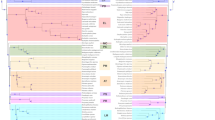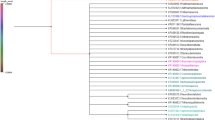Abstract
The complete mitochondrial genome 15,650 bp in size of the Deracantha onos has been determined. The gene content, base composition and codon usage of D. onos are coincident to typical hexapods mitochondrial genomes. Genes arrangement of D. onos is identical to Gryllotalpa orientalis, Ruspolia dubia and Anabrus simplex, in that the relative locations of tRNALys and tRNAAsp was different to that of Locusta migratoria. All tRNAs could be folded into the typical cloverleaf secondary structure, excluding tRNASer(AGN) which forms another structure according to the Steinberg–Cedergren tertiary structure. Sequence analysis of the A + T-rich region with Dot-plot did not find any conspicuous repeat clusters. Two poly-thymine (poly-T) nucleotide stretches of 20 bp and 11 bp in size, which may involved in the recognition of replication origin, were found on the H-strand and L-strand in the A + T-rich region of the D. onos mitogenome, respectively. One open reading frame (ORF) 87 amino acids in size was found on the H-strand, but Protein Blast searches analysis indicated that it was a nonfunctional ORF.



Similar content being viewed by others
References
Boore JL (1999) Animal mitochondrial genomes. Nucleic Acids Res 27:1767–1780
Wolstenholme DR (1992) Animal mitochondrial DNA: structure and evolution. Int Rev Cytol 141:173–216
Mueller RL (2006) Evolutionary rates, divergence dates, and the performance of mitochondrial genes in Bayesian phylogenetic analysis. Syst Biol 55(2):289–300
Sasaki T, Nikaido M, Hamilton H, Goto M, Kato H, Kanda N, Pastene LA, Gao Y, Fordyce RE, Hasegawa M, Okada N (2005) Mitochondrial phylogenetics and evolution of mysticete whales. Syst Biol 54(1):77–90
Solignac M (2004) Mitochondrial DNA in the Drosophlia melanogaster complex. Genetica 120:41–50
Flook PK, Rowell CH, Gellissen G (1995) The sequence, organization, and evolution of the Locusta migratoria mitochondrial genome. J Mol Evol 41:928–941
Kim I, Cha SY, Yoon MH, Hwang JS, Lee SM, Sohn HD, Jin BR (2005) The complete nucleotide sequence and gene organization of the mitochondrial genome of the oriental mole cricket, Gryllotalpa orientalis (Orthoptera: Gryllotalpidae). Gene 353:155–168
Fenn J, Cameron S, Whiting M (2007) The complete mitochondrial genome sequence of the Mormon cricket (Anabrus simplex: Tettigoniidae: Orthoptera) and an analysis of control region variability. Insect Mol Biol 16(2):239–252
Zhou ZJ, Huang Y, Shi FM (2007) The mitochondrial genome of the Ruspolia dubia (Orthoptera: Conocephalidae): a short A + T-rich region with 70 bp in length. Genome (in press)
Flook PK, Rowell CH (1998) Inferences about orthopteroid phylogeny and molecular evolution from small subunit nuclear ribosomal DNA sequences. Insect Mol Biol 7:163–178
Nikaido M, Rooney AP, Okada N (1999) Phylogenetic relationships among cetartiodactyls based on insertions of short and long interspersed elements: hippopotamuses are the closest extant relatives of whales. Proc Natl Acad Sci USA 96:10261–10266
Macey J, Schulte II J, Larson A (2000) Evolution and phylogenetic information content of mitochondrial genomic structural features illustrated with acrodont lizards. Syst Biologists 49:257–277
Sambrook J, Fritsch EF, Maniatis T (1989) Molecular cloning: a laboratory manual, 2nd edn. Cold Spring Habour Laboratory Press, New York
Liu N, Hu J, Huang Y (2006) Amplification of grasshoppers complete mitochondrial genomes using Long PCR. Chin J Zool 41(2):61–65
Simon C, Frati F, Bekenbach A, Crespi B, Liu H, Flook P (1994) Evolution, weighting and phylogenetic utility of mitochondrial genesequences and a compilation of conserved polymerase chain-reaction primers. Ann Entomol Soc Am 87:651–701
Staden R, Beal KF, Bonfield JK (2000) The Staden package, 1998. Methods Mol Biol 132:115–130
Lowe TM, Eddy SR (1997) tRNAscan-SE: a program for improved detection of transfer RNA genes in genomic sequence. Nucleic Acids Res 25:955–964
Kumar S, Tamura K, Nei M (2004) MEGA3: integrated software for molecular evolutionary genetics analysis and sequence alignment. Brief Bioinform 5:150–163
Clary DO, Wolstenholme DR (1985) The mitochondrial DNA molecule of Drosophila yakuba: nucleotide sequence, gene organization, and genetic code. J Mol Evol 22:252–271
Lavrov DV, Boore JL, Brown WM (2002) Complete mtDNA sequences of two millipedes suggest a new model for mitochondrial gene rearrangements: duplication and nonrandom loss. Mol Biol Evol 19(2):163–169
Okimoto R, Macfarlane JL, Wolstenholme DR (1990) Evidence for the frequent use of TTG as the translation initiation codon of mitochondrial protein genes in the nematodes, Ascaris suum and Caenorhabditis elegans. Nucleic Acids Res 18(20):6113–6118
Steinberg S, Leclerc F, Cedergren R (1997) Structural rules and conformational compensations in the tRNA L-Form J Mol Biol 266(2):269–282
Zagryadskaya EI, Kotlova N, Steinberg SV (2004) Key elements in maintenance of the tRNA L-shape. J Mol Biol 340:435–444
Sonnhammer EL, Durbin R (1995) A dot-matrix program with dynamic threshold control suited for genomic DNA and protein sequence analysis. Gene 167(1–2):GC1–GC10
Saito S, Tamura K, Aotsuka T (2005) Replication origin of mitochondrial DNA in insects. Genetics 171:1695–1705
Zhang DX, Szymura JM, Hewitt GM (1995) Evolution and structural conservation of the control region of insect mitochondrial DNA. J Mol Evol 40(4):382–391
Acknowledgements
We thank Dr. Lu Hui-meng for primers design and discussion during in the experiments. The study was supported by the National Natural Science Foundation of China (Grant Nos. 30470238 and 30670279) and Innovation Foundation of the Graduate Student Cultivation of the Shaanxi Normal University (Grant No. 2006CXB003).
Author information
Authors and Affiliations
Corresponding author
Rights and permissions
About this article
Cite this article
Zhou, Z., Huang, Y., Shi, F. et al. The complete mitochondrial genome of Deracantha onos (Orthoptera: Bradyporidae). Mol Biol Rep 36, 7–12 (2009). https://doi.org/10.1007/s11033-007-9145-8
Received:
Accepted:
Published:
Issue Date:
DOI: https://doi.org/10.1007/s11033-007-9145-8




